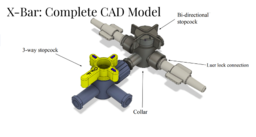Unified H-Bar
TECHNOLOGY NUMBER: 2020-331

OVERVIEW
- Eliminates connection failures compared to existing H-lock luer and lock designs
- Minimizes incorrect waveform readings and risks for infection, blood loss, and air embolism
BACKGROUND
A pulmonary artery catheter (PAC), which is also known as a Swan-Ganz catheter, is a medical device utilized in diagnostic procedures to measure pressures in the heart’s chambers and to deliver therapeutics. Pulmonary artery catheterization serves as an excellent tool for the assessment of patients with pulmonary hypertension, cardiogenic shock, or unexplained dyspnea. These catheters are typically inserted into a large vein — often in the neck, chest, or groin — and threaded toward the right side of the heart leading to the pulmonary artery. To assemble a PAC, caregivers are required to put together multiple individual transducers that will allow for the sampling of blood, infusion of saline, and monitor connections. This complex arrangement involves the attachment of between three and five stopcocks connected by a male to male adapter, along with a luer-lock adapter/sampling port. A need therefore exists for a simplified apparatus that serves the same function as existing PACs.
INNOVATION
Inventors have created a one-piece arrangement of valves and tubing connectors to facilitate monitoring, sampling, and infusion through the various lumens of a pulmonary artery catheter. The invention highlights a single device, a bidirectional stopcock, through which all lines of the catheter assembly can be connected. This design eliminates the risk of connection failures of the catheter assembly when compared to existing H-bar lumen and luer lock designs, minimizing the likelihood of incorrect waveform readings. The innovation also reduces the risk for infection, blood loss, and air embolism, thereby improving patient safety. The components of the device are sterile, transparent to permit light transmission, and capable of tolerating required flow rates. Testing has shown proper fluid flow through the stopcock, no observable leaking, and intuitive attachment of colored lumens between the catheters. Overall, this technology is fully compatible with Swan-Ganz catheter lumens and is intuitive and easy to use.